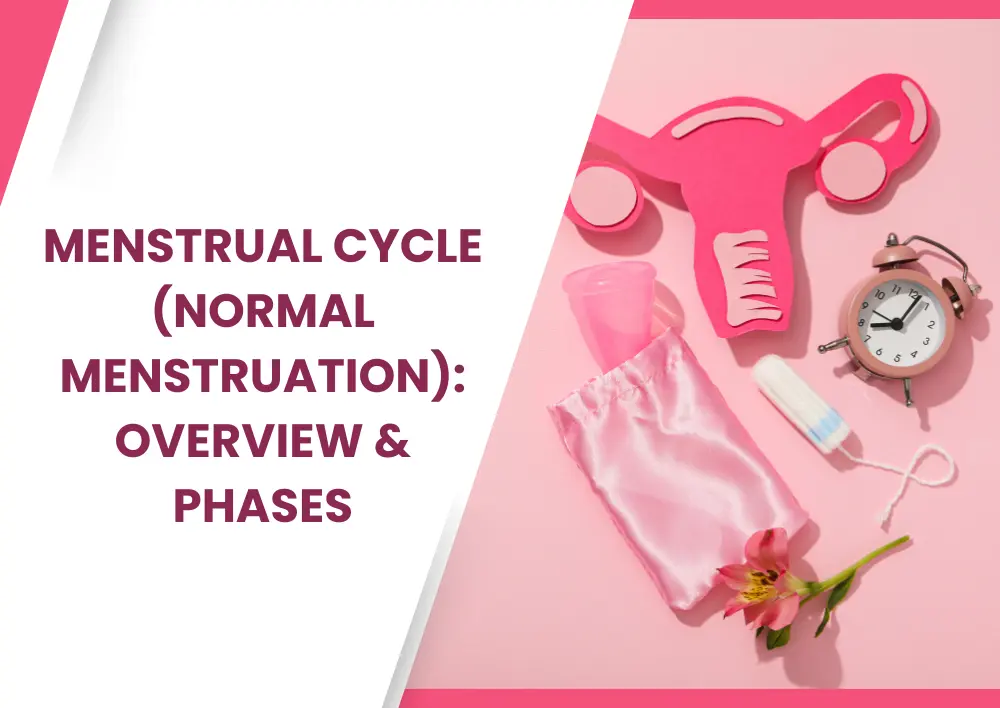Menstrual Cycle (Normal Menstruation): Overview & Phases
Summary
The menstrual cycle is a natural and integral part of a woman's reproductive health. It is a regular, monthly process that the female body undergoes in preparation for a potential pregnancy. On average, it lasts about 28 days, but it can vary from individual to individual, ranging anywhere from 21 to 35 days.
If you are experiencing an issue with menstruation, it's never too late to consult the menstrual problem gynae doctor near you at Miracles Apollo Cradle to make an informed decision about your well-being.
Let's discuss the complexity of the menstrual cycle, explore its phases, and highlight its importance in women's overall well-being.
What is menstruation?
Menstruation, often called a period, is a natural process that happens in a girl or woman's body. It's a way the body prepares for a possible pregnancy each month. Inside a girl's body, there is a special area called the uterus. Every month, the uterus gets ready in case there's a baby. If there is no baby, the uterus doesn't need the special area it prepared, so it lets it go. During this time, some blood and tissue from the uterus come out of the body through the vagina. This is what we call menstruation or having a period. It usually happens once a month, and it's a normal and healthy part of growing up for girls and women. Periods usually start during a girl's teenage years, and they continue until a woman reaches menopause, which is when she stops having periods as she gets older.
What is the menstrual cycle?
The menstrual cycle (period cycle) is a natural and complex process that occurs in the female reproductive system, staging a series of events each month. Generally spanning around 28 days, though variations are common, the menstrual cycle involves the cyclical changes necessary for a potential pregnancy. Divided into four different phases such as Menstrual, Follicular, Ovulatory, and Luteal, The period cycle is controlled by hormonal fluctuations.
The period cycle begins with the Menstrual Phase, during which the uterus sheds its lining, leading to menstruation that usually lasts 3 to 7 days. Following this, the Follicular Phase witnesses the development of ovarian follicles, preparing an egg for release. This phase, lasting from 7 to 21 days, sets the stage for the following Ovulatory Phase.
Menstrual cycle phases
The menstrual cycle consists of four main phases, each associated with different physiological changes and symptoms. Here are the phases of the menstrual cycle along with the symptoms associated with each phase.
-
Menstruation (Day 1-5): The menstrual cycle commences with the menstrual phase, characterized by the shedding of the uterine lining. Hormone levels drop, triggering the release of the lining and resulting in bleeding that generally lasts 3 to 7 days.
Symptoms of Menstruation: During menstruation, women commonly experience symptoms such as abdominal cramps, bloating, fatigue, and mood swings.
-
Follicular Phase (Day 6-14): This phase is marked by the growth of follicles in the ovaries, each containing an egg. Increasing levels of estrogen initiate the repair of the uterine lining, preparing it for a potential pregnancy. Ovulation occurs around the middle of the follicular phase, typically on day 14 for a 28-day cycle.
Symptoms of the Follicular Phase: Symptoms during the follicular phase may include increased energy levels, improved mood, and a rise in libido.
-
Ovulation (Day 14): Around the middle of the cycle, a mature follicle releases an egg from the ovary, making it available for fertilization. Ovulation is the most fertile period in the menstrual cycle.
Symptoms of Ovulation: Some women may experience symptoms like heightened senses, mild pelvic pain (mittelschmerz), and changes in cervical mucus consistency during ovulation.
-
Luteal Phase (Day 15-28): Following ovulation, the ruptured follicle transforms into a structure called the corpus luteum, producing progesterone. Progesterone maintains the uterine lining, preparing it for a potential embryo. If fertilization does not occur, hormone levels drop, initiating the start of the next menstrual phase.
Symptoms of the Luteal Phase: Common symptoms during the luteal phase include breast tenderness, mood swings, increased appetite, and sometimes, premenstrual syndrome (PMS) symptoms
At what age does menstruation typically begin?
Menstruation usually begins between the ages of 9 and 16. However, the average age for the first menstrual period is around 12 years old. Some girls may start their periods earlier or later than this general range. Factors such as genetics, nutrition, overall health, and environment can influence the timing of menstruation. If a girl hasn't started her period by the age of 16, she should consult with the best gynecology doctor for menstrual problems to ensure everything is developing as expected.
What are pre-period symptoms?
Pre-period symptoms are often referred to as premenstrual symptoms (PMS). The symptoms before the period may vary widely among females, and not everyone may experience them.
Here are common pre-period symptoms:
-
Mood Swings: Hormonal changes can cause mood changes, leading to feelings of sadness, anxiety, or irritability.
-
Breast Tenderness: Due to hormonal changes, Many females may experience tenderness or increased sensitivity in the breasts.
-
Bloating: Hormonal change and Water retention may cause discomfort and bloating.
-
Fatigue: Some individuals may experience a decrease in energy levels or feel fatigued before their period starts.
-
Cramping: Mild abdominal cramps or discomfort is common as the uterus prepares for menstruation.
-
Headaches: Hormonal changes may start headaches or migraines in some females during the premenstrual phase.
-
Acne and Skin Changes: Changes in hormones may lead to changes in the skin, including acne or increased oiliness.
-
Changes in Appetite: Some women may experience changes in appetite, cravings for certain foods, or an increased desire for sweet or salty snacks.
What is considered an irregular period?
An irregular period refers to a menstrual cycle that shifts from the usual pattern, which is often around 28 days. Irregular periods can be confirmed in various ways, including changes in cycle length, missed periods, or unexpected or heavy bleeding periods. Here are some common indications of an irregular menstrual cycle:
-
Cycle Length Variations: Irregular periods may involve period cycles that are consistently shorter or longer than the usual 28 days. For example, Menstrual cycles that are always less than 21 days or more than 35 days may be considered irregular.
-
Abnormal Bleeding: Irregular periods may involve generally light or heavy menstrual flow. Episodes of prolonged bleeding or abnormal bleeding between periods may also be considered irregular.
-
Irregular Menstrual Symptoms: Irregularity in premenstrual symptoms, such as breast tenderness, mood swings, or cramping with any clear pattern, may indicate irregular menstrual cycles.
-
Hormonal Imbalances: Irregular periods may be due to hormonal imbalance disorders such as polycystic ovary syndrome (PCOS) or thyroid. These disorders can affect the normal hormonal signals that regulate the period cycle.
-
Missed Periods: Missing, delayed menstrual cycles, or unpredictable gaps between menstrual cycles may also be a sign of irregularity. This can happen sometimes due to factors like stress or illness.
Infrequent irregularities are common and can be due to various factors such as stress, illness, lifestyle modification, or weight changes. However, continuous irregularities may need attention — consult an experienced Gynaecologist in Gurgaon
How do I track my period?
Tracking your period can help understand your menstrual cycle and identify patterns or irregularities. Here are several methods you can use to track your period:
-
Menstrual Calendar or Diary: Keep a simple calendar or diary where you mark the first day of your period each month. Note the duration of your period and any notable symptoms. This can help you identify patterns in your menstrual cycle.
-
Period Tracking Apps: There are several period tracking apps available for smartphones with features such as predicting your fertile window, recording symptoms, and sending reminders for your upcoming period.
-
Online Menstrual Cycle Calculator: Using online menstrual cycle calculators can help estimate the timing of your next period based on the length of your previous cycles.
-
Basal Body Temperature (BBT) Charting: BBT charting involves taking your temperature every morning before getting out of bed. A slight rise in body temperature can indicate ovulation, helping you identify your fertile window. It is highly effective for individuals who want to conceive.
-
Cervical Mucus Observation: Changes in the consistency of cervical mucus may indicate where you are in your menstrual cycle. It helps to track your ovulation.
-
Ovulation Predictor Kits: OPKs can help predict ovulation by detecting the rise in luteinizing hormone (LH) that precedes ovulation. Tracking your LH surge can give you a good idea of fertile windows.
Choosing a method or combination of methods may provide a more accurate picture of your menstrual cycle and help you anticipate when your period is likely to occur.
Importance of Tracking the Menstrual Cycle:
-
Reproductive Health: Irregularities in the menstrual cycle may indicate underlying health issues, such as hormonal imbalances or polycystic ovary syndrome (PCOS).
-
Overall Well-being: Information about the menstrual cycle can help individuals know reproductive health and well-being.
-
Fertility Awareness: Knowing the menstrual cycle helps individuals going for family planning identify their most fertile days.
Conclusion:
In conclusion, the menstrual cycle is a natural process necessary to a woman's reproductive health. Menstruation, beginning typically between the ages of 9 and 16, is a normal part of growing up and continues until menopause. Tracking the menstrual cycle, understanding its phases, and recognizing pre-period symptoms are essential for reproductive health awareness. Irregular periods may signify underlying health issues, making tracking methods valuable. By using calendars, apps, or more advanced techniques like BBT charting, individuals can gain insights into their menstrual patterns, promoting overall well-being and fertility awareness. Ultimately, embracing and understanding the menstrual cycle empowers individuals to navigate their reproductive health with knowledge and confidence.
If you have concerns about irregularities or difficulties with your menstrual cycle, consider consulting with a period problem gynecology specialist doctor at Miracles Healthcare, the best gynae hospital for menstrual problems for personalized guidance.
Frequently Asked Questions
The menstrual cycle is a natural monthly process driven by hormones, where the body gets ready for a possible pregnancy. It includes four key phases: menstruation, the follicular phase, ovulation, and the luteal phase.
A normal menstrual cycle lasts between 21 to 35 days, counted from the first day of one period to the next.
The menstrual cycle is commonly divided into three main phases: the follicular phase, when the egg matures; ovulation, when the egg is released; and the luteal phase, when the body prepares for a possible pregnancy.
Track the first day of your period each month using a calendar or app to monitor cycle length and regularity.
Menstruation is a sign of hormonal balance and reproductive health, and it helps prepare the body for potential pregnancy.
You may feel energetic during ovulation, emotional or tired before your period, and experience cramps or fatigue during menstruation.
A normal menstrual period usually lasts between 3 to 7 days.
You can visit Miracles Apollo Cradle in Gurgaon, where an expert team of female gynecologists provides specialized care for all types of menstrual problems using advanced diagnostic and treatment options.








.webp)







Was the information useful?
1 0